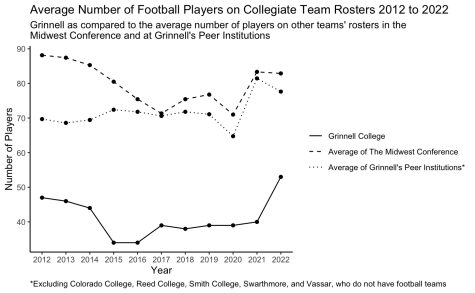Football focuses on increasing roster size
The Grinnell football team practicing in September 2022.
April 17, 2023
2023 Iowa College Media Association award winner, First Place – Best Print/Online Sports Reporting
Landon Skinner `24 had been at Occidental College for two years when the offensive lineman learned that his school would be discontinuing their football program. Skinner described the time as a “feeding frenzy” of other liberal arts institutions working to recruit anyone still looking to play. His ultimate journey to Grinnell, like many others on his team, began with a call from Head Football Coach Brent Barnes.
Prior to this decision, in 2017, Occidental had to cancel a season with four games remaining as injuries wore down the size of their roster. In 2019, Grinnell College had to make the same call with seven games remaining in the season as their team’s size had dwindled down to 28 players.
As a Division III institution that does not dole out scholarships or admission based on athletics, Grinnell has similarly struggled to maintain a sufficient number of players on their roster.
In fact, the Grinnell football team had the smallest roster in the Midwest Conference between 2012 and 2019. In the past couple years, however, Barnes said that he has worked to increase the average number of players on the team, and he continues to do so.
“There is a minimum [number of players] that you need to be able to practice and play safely,” Barnes said. “What that number is, that’s a great question. It’s probably higher than we are right now.”
Occidental College made the decision to officially end football at their school in October of 2020, citing concerns over the size of the roster. In order to withstand the inevitable injury and player loss that occurs over the course of a season, Occidental said that they would have to admit 5% of their incoming class, 20-25 students, as football players. They stated that the admissions cost and economic cost of trying to maintain a sufficient team at a school of their size was the reason for their decision.
Occidental College is not alone in these issues. For example, Swarthmore College and Colorado College ended their football programs in 2000 and 2008, respectively.
Grinnell has 16 official peer institutions, 5 of which — Colorado College, Swarthmore College, Vassar College, Reed College and Smith College — do not currently have football teams.
As of now, Grinnell’s roster has 53 players, 10 of whom are fourth-years. Roughly 20 new players have signed on to join the team for next year.

Barnes said that when looking at peer institutions like Carleton College, teams are able to be more competitive at the 70-80 player mark as they are able to more regularly switch out players on the field. However, Barnes said that he is not interested in growing to the 100-120 player size of some other schools in the conference, like Monmouth College.
“Players do not want to be the 23rd linebacker on a 28 linebacker crew,” he said. “That doesn’t excite a lot of kids who do the research with regards to what the roster might look like at other schools.”
Hugh Werner `25, defensive back, said that the small team size at Grinnell is also a benefit to team bonding.
“I think if you get on the other teams that are 100 plus, you find that the guys aren’t as dedicated,” said Werner. “It’s nice to have 41 guys that really care.”
With a larger group expected to play next year, Evan Stoller `26, tight end, said that he feels the team is successfully expanding in size. “We [the football team] weren’t even filling the buses,” he said. “But next year, we’re getting a lot more players. So there is clear improvement.”
Barnes said that he and the other coaches have done a better job of attracting players in the past two years, describing their recruitment model as “something we’ve kind of come up with in-house that works for us.” He continued, “I think the gist of it is it’s a unique school and a unique location.”
Barnes said that they are recruiting from the relatively small group of students who are looking to play college football and meet the right academic standard to receive admission to Grinnell. As a result, he said that he tries to communicate with prospective players directly.
Brandon Tennicott `26, defensive back, said that Barnes reached out to him through Twitter, and the ambition of everyone at the College drew him to attend.
Tennicott said that Grinnell is “just different from what my family has experienced, and I thought, ‘Why not break the box?’”
When comparing the College’s recruitment efforts to those of other colleges, Werner said, “Coach Barnes is definitely the best recruiter I [have] had. He was the most consistent in terms of checking in on me. It didn’t even have to be football-related.”
Barnes said that academics are ultimately the reason why many of his players end up at Grinnell. As such, he said that he emphasizes the elite academics of Grinnell when talking to potential players.
That reason was the most salient for Skinner, who said that he chose to transfer to Grinnell College for the academic opportunity.
“When I was narrowing down my list, I talked to people and they always said that they wish they had more Grinnell students to come to their grad programs,” said Skinner. “I knew it would be a place that set me up for success.”
Looking forward, Barnes said that the coaching staff is always discussing how to improve their strategies of direct communication, academic emphasis and prioritizing campus visits. He said that they debrief after each recruitment season and have worked to finetune the message they send to interested players.
Barnes said, “I think we are being a little bit more forceful about saying ‘Hey, here’s who we are, and here’s how we differ from other schools.’”





















































